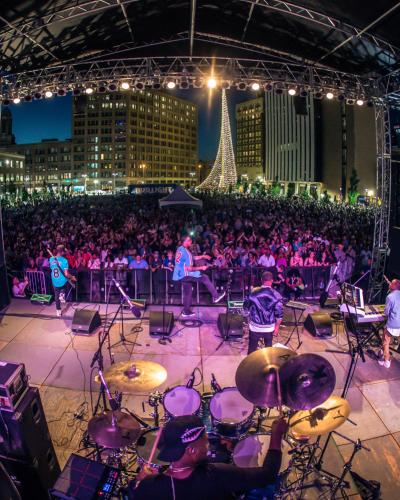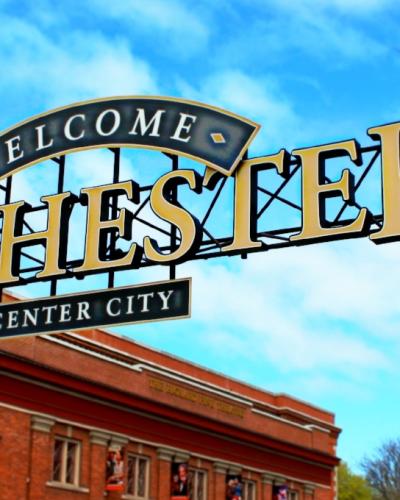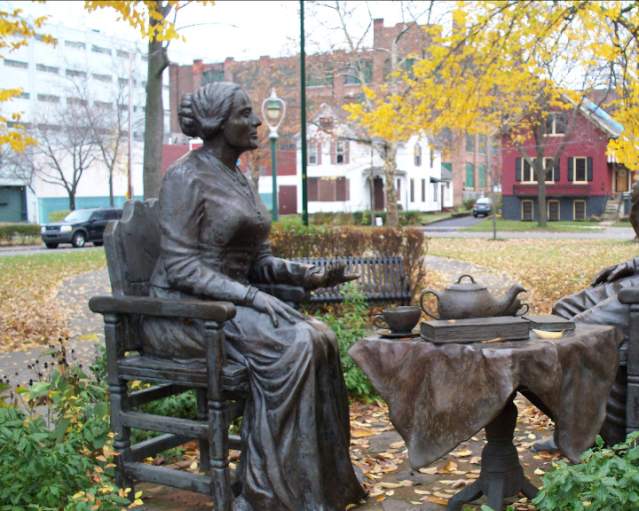History
Rochester is a city built on grit and grace. Instilled in our locals is a tenacious spirit influenced by famous residents that walked before us and tales of perseverance at every turn. Of course, you'll find architecture, museums, and monuments reminiscent of centuries past, but you'll also find an essence. It's the feeling you experience as you stand in the very spot that Susan B. Anthony was famously arrested for voting, or the breathtaking view of High Falls, a 96' waterfall in center city, that not only helped spur an industrial revolution in Rochester but was recognized by the area's earliest settlers of the Seneca Nation who referred to it as Great Seneca Falls.
Rochester's many identities over the years have been shaped by the city's storied history. From the young lion of the west to the flower city, learn more about America's first boomtown below and then experience it for yourself and become part of our history.
Women's Heritage & Rights
Leaders, creators, visionaries, reformers, pioneers or entrepreneurs. There's no place better…
African American Heritage
Rochester stands as an American beacon on several fronts, but none as noteworthy as its African…
Frederick Douglass
One of Rochester's most widely recognized contribution to African American history, stems from…
Flour to Flower
The region's rich agriculture and natural landscape shaped by the Genesee River and raging waterfalls created the perfect environment for flour production. Mills lined the riverfront, and using the power of High Falls, a 96' waterfall in the center of the city, Rochester became the largest manufacturer of baking flour in the world. Rochester flour was of such renowned quality that Queen Victoria was a customer, and we can also claim the birthplace of the graham cracker as a result. Whether you recognize Rochester as the 'Flour City' or America's first 'Boom Town,' it is due to the mid-19th century advent of the Erie Canal.
Along with milled grain and lumber, Rochester flour was transported via the Erie Canal. In its first ten days of operation, 3,600 tons of flour were shipped to the Hudson River. Coupled with rapid population growth, the city earned the moniker 'America's first Boom Town' and 'Young Lion of the West.' Upon its opening in 1825, the Erie Canal was considered the most significant engineering marvel in the world. Spanning 363 miles, it connected the Great Lakes to the Atlantic Ocean via the Hudson River and had an immediate impact, with travel time being cut in half and shipping rates dropping by 94%. Explore the Erie Canal in several historically charming villages nearby. You can kayak or boat or enjoy a cruise on the Sam Patch or Colonial Belle. You can also explore on foot or bike as you travel the Erie Canalway Trail, an easily accessible and mostly flat trail parallel to the waterway. In Rochester, you'll be in the middle of the 100 must-see miles of the Erie Canal.
Rochester's identity took on a different meaning as the 'Flower City' starting in the 1850s when horticulturists George Ellwanger and Patrick Barry gained international attention for their nursery business. This reputation is evident today, where visitors will notice the beautiful parks and gardens throughout the city and region, including over 500 varieties of lilacs in Highland Park. Enjoy the lilacs and much more at the annual Lilac Festival each May. The official start to festival season in Rochester, it is the largest free festival of its kind in North America. Highland Park and four others locally were designed by Frederick Law Olmstead, the visionary behind New York City's famous Central Park. Rochester is one of only four cities in the nation to boast a park system of his design.
World's Image Centre
Throughout the community, you'll see the name Eastman or hear its association. It's in the Eastman Theatre, Eastman School of Music, and Eastman School of Dentistry and Medicine at the University of Rochester. It's associated with Kodak, whose red company name is illuminated in the night skyline. This is the long-lasting legacy of George Eastman. His philanthropy made him the founding benefactor for educational and cultural institutes throughout the community, including the Rochester Philharmonic Orchestra, Rochester Institute of Technology, the United Way, and more.
Eastman was the pioneer of popular photography and motion picture film. His invention of the first flexible film camera helped expedite and simplify photography and was made available to the masses. Explore the life of George Eastman with a tour of his national historic landmark mansion and gardens at the George Eastman Museum. Discover his interest in architecture, technology, and music. Dive into the unparalleled collections—encompassing several million objects— in the fields of photography, cinema, and photographic and cinematographic technology. Immerse yourself in various galleries.
The George Eastman Museum is the world's oldest photography museum and one of the oldest film archives. You can also visit Eastman's childhood home at Genesee Country Village and Museum.
City Built on Civil Rights
Rochester has played a pivotal role in shaping American history due to two very famous residents leading two important movements with a shared vision; equality. Famed suffragist Susan B. Anthony lived and worked in Rochester for 40 politically active years. She was a leading champion for women's rights in the United States and was well known for her passionate speeches and sharp wit. In her lifetime, she fought for a woman's right to vote, own property, access education, and a fair wage, and in 1872 was famously arrested for voting in that year's presidential election. Today you can visit her home at 17 Madison Street and hear incredibly inspiring stories. Anthony was also a staunch Abolitionist, working alongside her friend and fellow Rochesterian, Frederick Douglass.
One of the foremost leaders of the Abolitionist Movement, Frederick Douglass was a social reformer, orator, writer, and statesman, who chose Rochester as the first city he would go on to live in as a free man. He was a resident from 1847-1872 and published the well-known abolitionist newspaper The North Star. He assisted Harriet Tubman in the dangerous work of helping slaves escape via the Underground Railroad, and his assistance came at one of the most crucial points of the flight, leading those to Kelsey's Landing, a point on the Genesee River that would lead to Canada by boat via Lake Ontario. While Douglass had moved on from Rochester at the time of his death, he chose the city as his final resting place, saying, "I shall always feel more at home there than anywhere in the country."
Tributes to both trailblazers are located throughout our community, including:
- Highland Park, the location of Frederick Douglass monument, which was the first statue in the United States to memorialize an African-American person.
- Thirteen life-size replica statues of the Douglass monument in Highland Park were installed in 2018 to commemorate Douglass's 200th birthday. The replica statues are placed throughout the community at places historically relevant to his time in Rochester.
- 1872 Café, the location of the polling place where Anthony cast that fateful vote for incumbent Republican Ulysses S. Grant.
- The Let's Have Tea statue at Susan B. Anthony Square Park, celebrating the friendship of Susan B. Anthony and Frederick Douglass and their shared goal of social justice and civil rights.
- Mount Hope Cemetery, the final resting place of both. Visit the Douglass Family Memorial and the grave of Anthony, which has become a place for pilgrimage, especially on election day.
- Learn more about Rochester and Douglass's role on the Underground Railroad at Rochester Museum and Science Center.
Indigenous Origins
Before the 19th century, the Seneca Nation, the largest of six Native American nations that comprised the Iroquois Confederacy or Six Nations, settled the land that would eventually become Rochester. Their settlement spanned across what today is known as the Genesee Valley and Finger Lakes regions of New York State. Throughout the Rochester region, their longhouses dotted the banks of the Genesee River in what was called the Seneca Heartland.
You'll find remnants of indigenous life throughout the region. Visit Letchworth State Park, the Grand Canyon of the East, for breathtaking views of the Genesee Valley and a 1765 Seneca Council House. You'll also learn the tale of Mary Jemison, also known as the 'White Woman of the Genesee.' Jemison was captured at 12 years old as part of a Shawnee morning raid and adopted by a Seneca family. Having fully assimilated, she married into the Seneca Nation as an adult and raised several children. When offered the chance to return to British colonial culture later in life, she remained a member of the Seneca Nation. A cabin belonging to Jemison's daughter, Nancy, was acquired by the park in 1881.
Further, immerse yourself in indigenous culture with a visit to Ganondagan State Historic Site. Experience authentic Seneca and Haudenosaunee (Iroquois) culture while exploring interactive exhibits at the Seneca Art & Culture Center. And as you explore interpreted scenic trails on nearly 600 acres, you'll discover a full-size Seneca bark longhouse. As you walk the grounds, reflect on the knowledge that a 17th century Seneca town existed peacefully on these same grounds 350 years ago.
Rochesterville
The quest to acquire land in the "new frontier" led Revolutionary War soldier and well-to-do landowner Nathaniel Rochester from Hagerstown, Maryland, to the area in 1800. Along with William Fitzhugh and Charles Carroll, 100 acres of land were purchased around High Falls for $1,750. Col. Rochester began to develop streets and plots of land for municipal, church, and business use and named it Rochesterville. The population multiplied as the War of 1812 forced settlers inland from the shores of Lake Ontario. You can explore his original plank house from his first settlement at Genesee Country Village and Museum, and a visit to Nathaniel Rochester Square in the South Wedge neighborhood will lead you to a statue of Rochester's founder.










